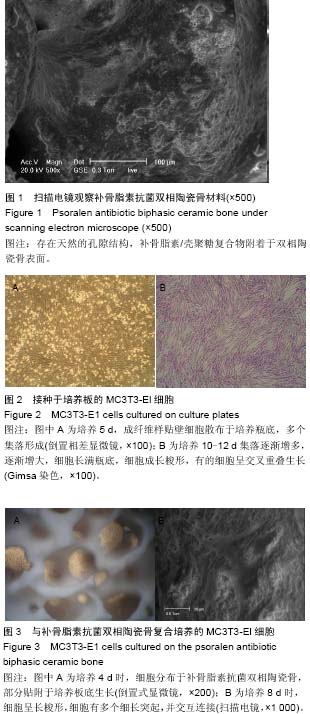| [1] 倪建光,刘丹平.骨组织工程支架材料的研究进展[J].中国组织工程研究与临床康复,2009,13(8):1525-1528.
[2] 修晓光,李彦林,李雅娜,等.双相陶瓷生物骨的制备和细胞相容性研究[J].昆明医学院学报,2005,26(2):59-62.
[3] Kurashina K,Kurita H,Wu Q,et al.Ectopic osteogenesis with biphasic ceramics of hydroxyapatite and tricalcium phosphate in rabbits.Biomaterials.2002;23(2):407-412.
[4] 明磊国,陈克明,葛宝丰,等.异补骨脂素对体外培养大鼠成骨细胞增殖分化成熟的影响[J].中药材,2011,34(3):404-408.
[5] 殷雪,周岿,王春颖,等.壳聚糖改性、抑菌性及成膜性研究[J].武汉工业学院学报,2008,27(3):18-22.
[6] Wong RW,Rabie AB.Effect of psoralen on bone formation.J Orthop Res.2011;29(2):158-164.
[7] Wilson CE,van Blitterswijk CA,Verbout AJ,et al.Scaffolds with a standardized macro-architecture fabricated from several calcium phosphate ceramics using an indirect rapid prototyping technique.J Mater Sci Mater Med.2011;22(1): 97-105.
[8] 李景峰,郑启新,郭晓东.表面修饰煅烧骨的制备及其理化性质的研究[J].生物医学工程学杂志,2012,29(3):474-478.
[9] Verron E, Khairoun I,Guicheux J,et al.Calcium phosphate biomaterials as bone drug delivery systems:a review.Drug Discov Today.2010;15(13-14):547-552.
[10] 谢安,付建华,陈义旺.芳香/脂肪共聚酯生物材料与大鼠骨髓间充质干细胞的相容性实验[J].中国组织工程研究与临床康复, 2009,13(38):7517-7522.
[11] Lin K,Xia L,Gan J.Tailoring the nanostructured surfaces of hydroxyapatite bioceramics to promote protein adsorption, osteoblast growth, and osteogenic differentiation.ACS Appl Mater Interfaces.2013;28(16):8008-8017.
[12] 齐宝闯,唐辉,周田华,等.纳米羟基磷灰石骨修复材料研究进展[J].国际骨科学杂志,2010,31(5):305-307.
[13] Luo Y, Wang Q.Recent development of chitosan-based polyelectrolyte complexes with natural polysaccharides for drug delivery.Int J Biol Macromol.2014;64:353-367.
[14] Wu QX,Lin DQ,Yao SJ.Design of chitosan and its water soluble derivatives-based drug carriers with polyelectrolyte complexes.Mar Drugs.2014;12(12):6236-6253.
[15] Hamman JH.Chitosan based polyelectrolyte complexes as potential carrier materials in drug delivery systems.Mar Drugs. 2010;8(4):1305-1322.
[16] Jiang F,Deng Y,Yeh CK,et al.Quaternized chitosans bind onto preexisting biofilms and eradicate pre-attached microorganisms.J Mater Chem B Mater Biol Med.2014;2(48): 8518-8527.
[17] Aimin C,Chunlin H,Juliang B,et al.Antibiotic loaded chitosanbar.An in vitro, in vivo study of a possible treatment for osteomye-litis.Clin Orthop Relat Res.1999;36(6): 239-247.
[18] 蔡玉霞,张剑宇.补骨脂水煎剂对去卵巢骨质疏松大鼠骨代谢的影响[J].中国组织工程研究与临床康复,2009,13(2):268-270.
[19] 杨荣平,寿清耀,涂永勤,等.补骨脂提取物对体外培养新生大鼠颅骨成骨细胞的影响[J].中国新药与临床药理,2007,18(1):32-34.
[20] 张润荃,史凤芹,庞淑珍,等.补骨脂对分离破骨细胞作用研究[J].现代口腔医学杂志,1995,9(3):136-138.
[21] Hsu PJ,Miller JS,Berger JM.Bakuchiol, an antibacterial component of Psoralidium tenuiflorum.Nat Prod Res.2009; 23(8):781-788.
[22] Yin S,Fan CQ,Wang Y,et al.Antibacterial prenylflavone derivatives from Psoralea corylifolia, and their structure-activity relationship study.Bioorg Med Chem. 2004;12(16):4387-4392.
[23] Sheng Y,Cheng QF,Lei D,et al.Psoracorylifols A-E,fivenovel compounds with activity against Helicobacter pylori from seeds of Psoralea corylifolia.Tetrahedron.2006;62:2569-2575. |
